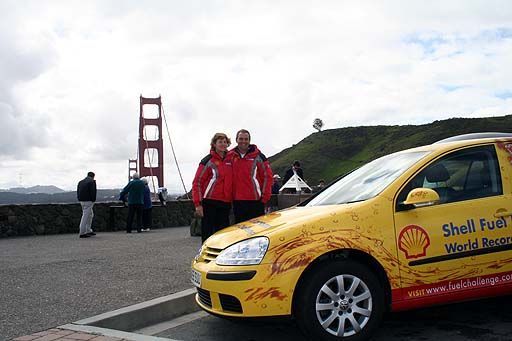John and Helen Taylor begin the North American leg of their historic pursuit to set a Guinness World Record for Fuel Efficiency by circumnavigating the globe in a standard car, across 18,000 miles and 25 countries -- using as little gasoline as possible.
The Taylors, arguably the world's most fuel efficient drivers with 34 fuel economy driving achievements between them, started their journey on January 17 in London. To date, they have tackled the roads across Europe, Asia, Australia and New Zealand, encountering everything from ice storms, flash floods and a tornado to dancing camels and donkey carts. The Taylors have driven 12,700 miles to date and have been averaging 51 miles per gallon by using Shell fuel and employing Shell FuelStretch principles, which includes driving and vehicle maintenance tips.
The Taylors and crew spend up to 14 hours a day on the road, driving both day and night, while adhering to strict health and safety guidelines. They also follow a strict and limited eating regime to minimize the risk of illness that could affect achieving the record. One break for the couple, however, came mid-journey, when they stopped at home in Melbourne, Australia, to attend their daughter's wedding.
The U.S. Route}0}
The North American leg begins in San Francisco at the iconic Golden Gate Bridge, followed by the Taylors and their support crew driving south to Los Angeles, and then heading east across the country through Arizona, New Mexico, Texas, Missouri, Ohio, Illinois, Michigan, Canada and New York. The Taylors expect to fill up about five times along the route, before ending in New York City on March 24.
The Taylor's attempt to set the best fuel efficiency record possible will be challenged by mountainous roads, gridlock around major American cities and potentially challenging winter road conditions. However, they have every confidence they will achieve their goal of 35 fill-ups or less for the global journey, which ends in London in early April after crossing Portugal, Spain and France.
"Given the United State's reputation for a wide variety of terrain, traffic congestion and road conditions this time of year, the U.S. leg will continue to test our ability to get the best fuel economy possible," said John Taylor. "However, by implementing FuelStretch driving tips, which any driver can use, we believe we are on our way to setting a Guinness World Record that will be tough to beat!"
Teaching Drivers About FuelStretch Driving Principles}0}
Drivers looking to get the most out of every gasoline purchase can get helpful hints from Shell "FuelStretch," a new program being offered at Shell stations nationwide. Designed to help drivers save money and get the most out of their car choice, FuelStretch offers motorists money-saving driving tips, a credit card that helps drivers earn gasoline rebates on every purchase they make, and innovative fuels that are specially formulated to help keep engines clean.
As part of their attempt to achieve the Guinness World Record for fuel efficiency, the Taylors have been practicing Shell FuelStretch driving principles. The FuelStretch tips for vehicle maintenance and driving techniques have helped the Taylors decrease overall fuel consumption, including actions such as using cruise control on major roads and in free-flowing traffic, avoiding idling and higher speeds and minimizing vehicle drag.
For the attempt to qualify as an official Guinness World Record, the Taylors must travel in one direction, covering a distance of at least 18,000 miles, but no more than the full length of the Equator. The car needs to be a standard production model. There are 18 other strict rules covering antipodal points, East/West co-ordinates, independent adjudication, log books, witnesses, pre-travel engineering checks, and driving times.
"We're excited about this new challenge as it represents the most ambitious global fuel efficiency record attempt to date," says Craig Glenday, editor of Guinness World Records. "It's a timely representation of what attempting a Guinness World Record is all about -- pushing the boundaries of human and technological achievement while carrying along with it some helpful tips to demonstrate how every driver can save money on fuel."

